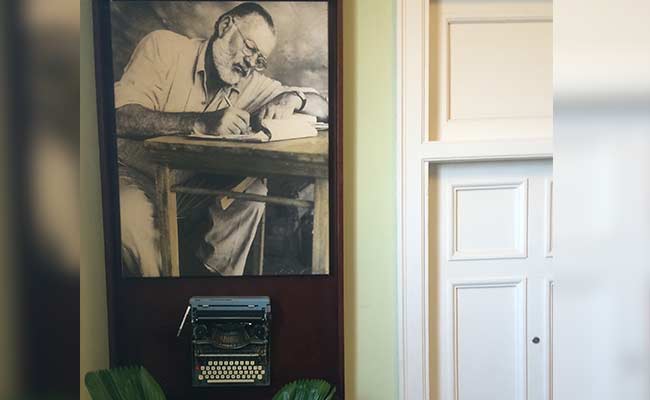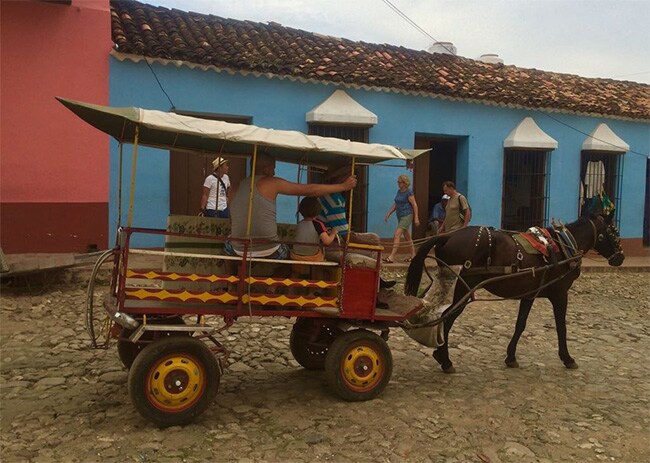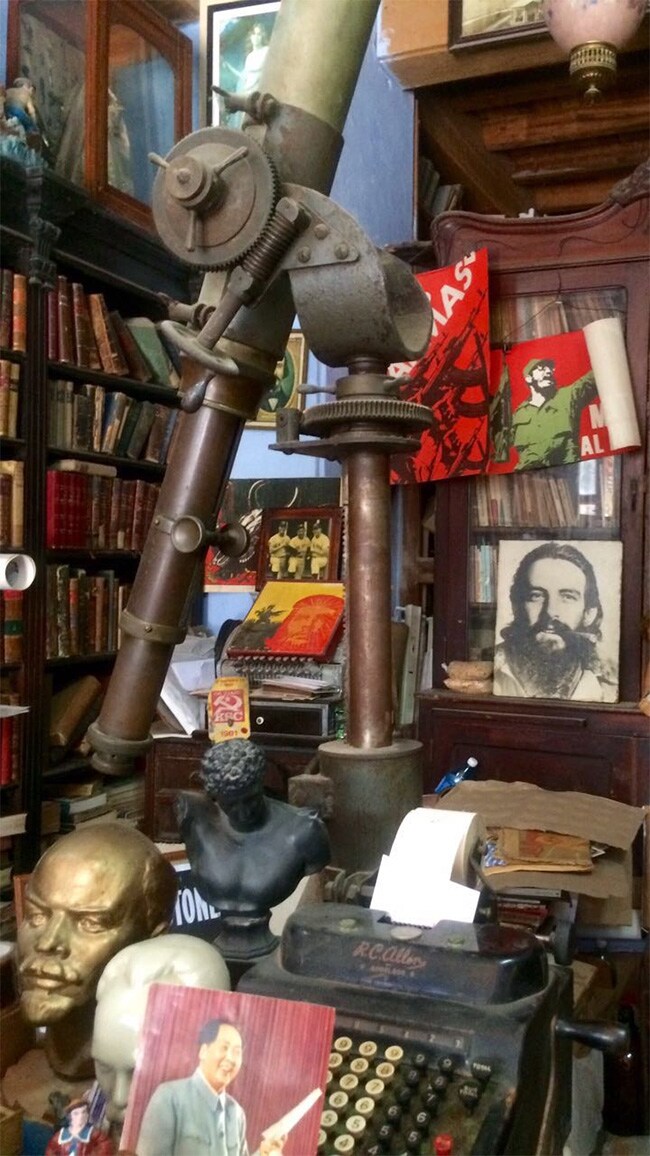"Finally, the times are changing," Mick Jagger told a wildly cheering crowd at the Rolling Stone concert in Havana.
And so I rushed to Cuba before McDonalds and Disney. Standing in the immigration line at Jose Marti International airport I see, the Chinese, Europeans and even the Americans had suffered a similar panic attack.
I handed my passport to a young officer, she took one look at my nationality and asked me to stand aside, while another questioned me at length about my visit.
Revolutionary hero, Che Guevara's image dominates Cuba's landscape
Didn't they know, I fumed, that India and Cuba had been good friends since before the hero of their revolution and former president, Fidel Castro publicly hugged Indira Gandhi at the Non-Aligned Movement conference in New Delhi in 1983?
But what I didn't know was that in the last few years South America and Cuba had become the preferred route for Indians trying to enter Canada and America illegally.
In the small luggage collection area, crammed with people and reminding me of our airport terminals a decade ago, there is no profiling. Everyone stands around for hours as the suitcases arrive one at a time.
Outside, Dina was waiting for me in a shocking pink Cadillac. The parking resembles a Hollywood film set from the 1950s. With jewel coloured vintage American cars. Dodges, Chevys, Austins and a large number of Russian-made Lada sedans. It's the ingenuity or
jugaad of local mechanics which keeps them running and shiny for hordes of selfie-clicking tourists
US economic sanctions ensured Cuba's roads are still crowded with vintage cars
Dina has been driving a taxi for nearly 10 years now after quitting her job as a high school teacher. "My salary was not enough to raise two children. Cuba was on the verge of becoming an attractive holiday destination, and I decided to take my chances." A steady flow of tips has upped her family's standard of living and Dina is now dreaming of buying her own car. (During my stay in Cuba I met a number of people in the hospitality business, from tour guides to bartenders, who were also doctors and college professors, trying to making a little extra money in their free time)
Today, Cuba is experiencing a tourist boom. On offer stretches of white sand beaches, unlimited mojitos and Pina coladas, Che Guevara memorabilia, salsa and for vegetarians like me, believe it or not, an amazing choice of food.
White sand beaches line the aquamarine waters of the Caribbean Sea
(The story goes, that after Cuba's benefactor the Soviet Union disintegrated in the early 1990s, cooking gas and petroleum products became scarce. The brutal US trade embargo prevented imports of food items. Till almost the end of the decade the country was on the brink of famine. The animals were all dead. People were forced to grow and eat vegetables. And even though meat has returned on the menus, Cuba continues to be a vegetarian's delight.)
But like many others I have travelled here for a nostalgia high, and find it in the country's architecture. A glitzy, intricate and exaggerated mix of European and American styles which became fashionable between 1860 and 1960. Baroque, neo-classical, art nouveau and art deco, interspersed with later Soviet-influenced modernist structures.
Havana's Art Nouveau legacy includes highly ornamental public sculptures
There are hundreds of buildings in Havana alone, which are of historical importance. Located around its colonial squares, along the 8 km long sea drive and across the city's residential districts. Pointing to a time when Cuba was flush with sugar money. Whether it's the Cathedral of San Cristobal with its theatrical facade, the flamboyant town houses of former aristocrats, the Museum of Decorative Arts, a 1920s Louis XV-style gem, the Bacardi tower or the Hotel Nacional de Cuba, overlooking the shark-infested Straits of Florida. Once the playground of the American mafia, its Churchill Bar, where everyone from author Gabriel Garcia Marquez to actor Marlon Brando dropped in for a drink, still attracts a large number of visitors.
The bar which played host to a range of celebrities from Walt Disney to Winston Churchill
It's not easy to pick favourites, but I must admit to falling in love with the old chemist shops turned museums, with their rows of white ceramic medicine jars lining dark wooden shelves. And the Ambos Mundos Hotel, where the flamboyant Ernest Hemingway is said to have written part of his classic, "For Whom the Bell Tolls." The Floridita was another of his favourite haunts where the drinking is still serious.
Ambos Mundos Hotel in Old Havana where Ernest Hemmingway is said to have written part of 'For Whom the Bell Tolls'
Frank Mendez is my man in Havana. Guide, driver and bully who insists that the West has demonised Cuba's communist regime and Fidel Castro who has consistently tried to save its crumbling heritage and supported the crazy, impossible dreams of Eusebio Leal, the City's Historian.
Leal, I discovered is something of a rock star in Cuba. In 1967 as a 25-year-old conservationist he lay down on an old street in the heart of Havana to stop the local authorities from covering it with asphalt for a diplomatic visit. Leal, the story goes, refused to move till the mayor assured him that the road would not be paved. He has since rescued hundreds of mansions, offices, churches, factories and theatres from neglect and certain death.
But Leal who is a member of the Communist Party's Central Committee is clear that tourism cannot be allowed to overwhelm and destroy local cultures and everyday life. Today, museums and boutique hotels share street space with health clinics and grocery stores. Spectacular edifices rub shoulders with laundry draped balconies. And as I walk the city, I can feel that it's energy comes from ordinary Cubans who work, study and retire in the midst of all the decay and splendour.
A contemporary work of art in one of Havana's old squares
Frank, I could see was proud of his heritage, so I was shocked to learn he was moving from Havana to Miami in less than a month to join the rest of his family. Last year, nearly 40,000 Cubans left the country, mostly for America, despite the relaxation of Communist rigor by Raul Castro after he became President in 2008. People can now purchase mobile phones which recorded the arrival of the Rolling Stones on stage for posterity, buy and sell residential real estate after nearly half a century and legally operate private business. In 2012, they were also allowed to travel abroad without any restrictions.
But the change is not coming fast enough for Frank, and although the rise and rise of Donald Trump and his anti-migrant rhetoric is making the 30-year-old nervous, he is determined to go. Repeatedly assuring me that it is possible to be both a Cuban patriot and a US citizen
When I asked him, what will he miss the most, Frank's answer came straight from the heart. "Son, salsa, cha-cha, timba and rumba"
The nights in Cuba are for song and dance. A fusion of genres from Latin America, Africa, Spain, America and the Caribbean islands. The world rediscovered one strain of the nation's unique musical tradition in 1996 with the release of Buena Vista Social Club a documentary showcasing several performers from the pre-evolution Big Band era. Sadly the original club in Havana from which the film borrowed its name shut in the 1940s. It's place, I found had been taken by a pretender (The open air Tropicana Cabaret since 1939 however retains some of its charm and shimmy).
The open air Tropicana Cabaret since 1939 retains some of its charm and shimmy
Locals agreed that the huge success of the film, gave a major boost to the country's tourism industry, then in its infancy."But it eclipsed all other rhythms and beats coming out of here in the last 50 years," Maria Luis informs me. She sings at one of the music clubs in Trinidad and possesses an eclectic repertoire. Of traditional and folk, funk, jazz and reggae. In this historical, perfectly preserved town with its cobbled streets, Spanish colonial buildings and horse drawn carriages which was declared a UNESCO heritage site in 1988, Maria's sound is distinctly modern and international. "It's what we listen to," she pointedly tells me, "not what you want to hear".
Trinidad, a UNESCO world heritage offers some of the best live music
"There's a big deal being made of the mystique of an earlier era," says Nester a lawyer I meet in Cienfuegos. The whimsical seaside town of neo-classical buildings in pretty pastels, often called the Paris of the Caribbean would make anyone pine for the past. But the present is not too bad, insists Nester. While he admits that the average Cuban earns as little as $20-30 a month, this income is augmented by government subsidies and, for many, remittances from family members living abroad. Literacy in Cuba is 98%, it has the best public health system in Latin America and regularly sends doctors to Africa (they were at the forefront of the fight against Ebola) and conflict zones, where only organisations like Doctors Without Borders will go. And what I could not fail to notice is that despite a strong element of censorship, writers and artists are still amongst Cuba's privileged class.
Fidel@90 is still a hero in Cuba
Today there are many ideas of Cuba at conflict with each other as the nation celebrates the 90th birthday of Fidel Castro. Some remain committed to his socialist dream, others insist, that while they are not denying history, the impatience for change is growing stronger
"Romanticizing the past is not a good thing. Cubans deserve to join a world that has moved on without them." said Havana based town planner Miguel Coyula in a magazine interview.
I couldn't agree more.
(Shikha Trivedy is Features Editor, NDTV 24x7)Disclaimer: The opinions expressed within this article are the personal opinions of the author. The facts and opinions appearing in the article do not reflect the views of NDTV and NDTV does not assume any responsibility or liability for the same.












